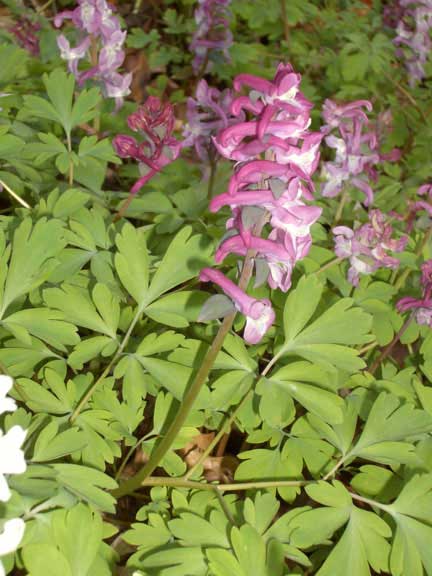
Corydalis cava (*)
Classification System: APG IV
Superregnum: Eukaryota
Regnum: Plantae
Cladus: Angiosperms
Cladus: Eudicots
Ordo: Ranunculales
Familia: Papaveraceae
Subfamilia: Fumarioideae
Tribus: Fumarieae
Genus: Corydalis
Species: Corydalis cava
Subspecies: C. c. subsp. cava – C. c. subsp. marschalliana
Name
Corydalis cava (L.) Schweigg. & Körte, Fl. Erlang. 2: 44 (1811).
Synonyms
Basionym
Fumaria bulbosa var. cava L., Sp. Pl. 2: 699, 1753.
Heterotypic
Fumaria major Roth, Tent. Fl. Germ. 1: 300, 1788.
Corydalis albiflora Kit., Linnaea 32: 491, 1863.
Corydalis stummeri Pant., Oesterr. Bot. Z. 31: 347, 1881.
References
Links
Hassler, M. 2020. Corydalis cava. World Plants: Synonymic Checklists of the Vascular Plants of the World In: Roskovh, Y., Abucay, L., Orrell, T., Nicolson, D., Bailly, N., Kirk, P., Bourgoin, T., DeWalt, R.E., Decock, W., De Wever, A., Nieukerken, E. van, Zarucchi, J. & Penev, L., eds. 2020. Species 2000 & ITIS Catalogue of Life. Published on the internet. Accessed: 2020 March 16. Reference page.
Govaerts, R. et al. 2020. Corydalis cava in Kew Science Plants of the World online. The Board of Trustees of the Royal Botanic Gardens, Kew. Published on the internet. Accessed: 2020 March 16. Reference page.
International Plant Names Index. 2020. Corydalis cava. Published online. Accessed: 16 March 2020.
Vernacular names
čeština: Dymnivka dutá
Cymraeg: Corydalis Gwagwraidd
dansk: Hulrodet Lærkespore
Deutsch: Hohler Lerchensporn
English: Hollowroot
español: Apios de algunos
suomi: Etelänkiurunkannus
français: Corydale creuse
Frysk: Holwoartel
hornjoserbsce: Pyšny kokorč
magyar: Odvas keltike
italiano: Colombina cava
lietuvių: Tuščiaviduris rūtenis
Nederlands: Holwortel
polski: Kokorycz pusta
русский: Хохлатка полая
slovenčina: Chochlačka dutá
svenska: Hålnunneört
українська: Ряст порожнистий
Corydalis cava is a species of flowering plant in the family Papaveraceae, native to moist, shady, woodland habitats throughout most of mainland Europe, although commonest in central and southeast Europe. Its range extends from Spain in the west to Ukraine, Belarus and the Caucasus in the east and as far north as Sweden. It is absent from (though may sometimes be found in a naturalised state in) Iceland, the UK, the Netherlands, Norway, Finland, Russia and Greece.[1]
Description
Corydalis cava grows 15 cm (6 in) to 30 cm (12 in) tall. It is a spring ephemeral—foliage that grows in the spring dies down to its tuberous rootstock in summer. It has long-spurred flowers which appear in spring. The flowers may be mauve, purple, red, or white.
The seeds contain an elaiosome that attracts ants, which transport the seeds into their ant colony. This seed transportation is called myrmecochory.
Toxicity
Structure of the Isoquinoline alkaloid bulbocapnine
Structure of the isoquinoline alkaloid canadine
Many of the species in Corydalis contain alkaloids such as canadine and corydaline, which blocks calcium. The majority of these belong to the isoquinoline alkaloid group.[2] All parts of the plant are alkaloidal but the highest concentrations are present in the hollow root tuber.
Corydalis cava and some other tuberous species contain the alkaloid bulbocapnine, which is occasionally used in medicine but for which scientific evidence is lacking in regard to correct dosage and side effects.[3]
References
Kew Plants of the World Online http://www.plantsoftheworldonline.org/taxon/urn:lsid:ipni.org:names:672129-1 Retrieved at 9.53 on 14/9/20.
Whitney, Stephen (1985). Western Forests (The Audubon Society Nature Guides). New York: Knopf. p. 556. ISBN 0-394-73127-1.
"CORYDALIS". WebMD. Retrieved 21 October 2014.
Retrieved from "http://en.wikipedia.org/"
All text is available under the terms of the GNU Free Documentation License

